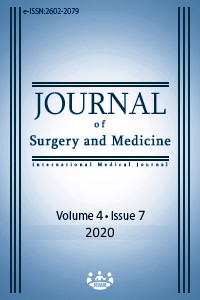Estimation of renal scarring in children with lower urinary tract dysfunction by utilizing resampling technique and machine learning algorithms
Keywords:
Artificial intelligence, Machine learning, Renal Scar, Lower urinary tract dysfunction, ChildrenAbstract
Aim: Classical database methods may be inadequate for large data sets accumulating continuously. Machine learning (ML), one of the main subsets of artificial intelligence, may solve this problem and find the best solution for future problems by gaining experience from the present data in medical studies. A method that may show the correlation between clinical findings and renal scarring (RS) with high accuracy in patients with lower urinary tract dysfunction (LUTD) is needed. In this study, the aim is to establish a model for the prediction of RS in children with LUTD by using ML.
Methods: Patients older than three years of age (n=114) who needed urodynamic study were included in the study. There were 47 variables in the data set. Variables such as symptomatic urinary tract infection, vesicoureteral reflux, bladder trabeculation, bladder wall thickness, abnormal DMSA scintigraphy, and the use of clean intermittent catheterization were recorded. Several ML techniques (MLT) were applied to estimate RS.
Results: As a result of the comparisons, the highest accuracy rate according to the confusion matrix was obtained by the Extreme Gradient Boosting (XGB) algorithm (91.30%). In the balanced (SMOTE) data set, the highest accuracy rate was obtained by the Artificial Neural Network (ANN) algorithm (90.63%). According to the Receiver Operating Characteristic (ROC), the highest success rate was obtained by the ANN algorithm in the balanced (SMOTE) data set (90.78%).
Conclusion: High accuracy rates obtained by MLT may suggest that MLT might provide a faster and accurate evaluation process in the estimation of RS in patients with LUTD.
Downloads
References
Lopes M, Ferraro A, Dória Filho U, Kuckzinski E, Koch VH. Quality of life of pediatric patients with lower urinary tract dysfunction and their caregivers. Pediatr Nephrol. 2011;26:571-7. doi: 10.1007/s00467-010-1744-2
Neveus T, von Gontard A, Hoebeke P, Hjalmas K, Bauer S, Bower W, et al. The standardization of terminology of lower urinary tract function in children and adolescents: report from the Standardisation Committee of the International Children’s Continence Society. J Urol. 2006;176:14–24. doi: 10.1016/S0022-5347(06)00305-3
Bauer SB. Special considerations of the overactive bladder in children. Urology. 2002;60:43-8. doi:10.1016/S0090-4295(02)01793-4
Siegel E. Predictive Analytics: The Power to Predict Who Will Click, Buy, Lie, or Die. Hoboken, NJ, John Wiley & Sons. 2013.
Johnso AEW, Ghassemi MM, Nemati S, Niehaus KE, Clifton DA, Clifford GD. Machine learning and decision support in critical care. Proceedings of the IEEE. 2016;104:444–66. doi:10.1109/JPROC.2015.2501978
Dugas AF, Kirsch TD, Toerper M, Korley F, Yenokyan G, France D, et al. An electronic emergency triage system to improve patient distribution by critical outcomes. J Emerg Med. 2016;50:910–18. doi: 10.1016/j.jemermed.2016.02.026
Levman J, Takahashi E. Multivariate analyses applied to fetal, neonatal and pediatric MRI of neurodevelopmental disorders. Neuroimage Clin. 2011;9:532–44. doi:10.1016/j.nicl.2015.09.017
Levman J, Takahashi E. Pre-adult MRI of brain cancer and neurological injury: multivariate analyses. Front Pediatr. 2016;4:65. doi:10.3389/fped.2016.00065
Hansson S, Jodal U. Urinary tract infection. In: Avner ED, Harmon W, Niaudet P (eds). Pediatric nephrology. Lippincott Williams & Wilkins, Philadelphia. 2004;1007–25.
Chang SJ, Chiang IN, Hseih CH, Lin CD, Yang SS. Age and gender specific nomograms for single and dual post void residual urine in healthy children. Neurorol Urodynam. 2013;32:1014–8. doi:10.1002/nau.22342
Abrams P, Cardozo L, Fall M, Griffiths D, Rosier P, Ulmsten U, et al. The standardization of terminology of lower urinary tract function. Neurourol Urodyn. 2002;21:167–78.
Osmanoglu UO, Atak ON, Caglar K, Kayhan H, Can TC. Sentiment Analysis for Distance Education Course Materials: A Machine Learning Approach. Journal of Educational Technology and Online Learning. 2020;3(1):31-48. doi: 10.31681/jetol.663733
Sun Y, Kamel MS, Wong AK, Wang Y. Cost-sensitive boosting for classification of imbalanced data. Pattern Recognition. 2007;40(12):3358-78. doi:10.1016/j.patcog.2007.04.009
https://docs.microsoft.com/en-us/azure/machine-learning/studio-module-reference /smote (Access Date: 21/08/2019)
Celik O, Osmanoglu UO. Comparing to Techniques Used in Customer Churn Analysis. Journal of Multidisciplinary Developments. 2019;4(1):30-8. http://www.jomude.com/index.php/jomude/article/view/62
Wong TT. Performance evaluation of classification algorithms by k-fold and leave-one-out cross validation. Pattern Recognition. 2015;48(9):2839-46. doi: 10.1016/j.patcog.2015.03.009
Veloso LA, Mello MJ, Ribeiro Neto JP, Barbosa LN, Silva EJ. Quality of life, cognitive level and school performance in children with functional lower urinary tract dysfunction. J Bras Nefrol. 2016;38:234–44. doi: 10.5935/0101-2800.20160033
Merritt JL. Residual urine volume: correlate of urinary tract infection in patients with spinal cord injury. Arch Phys Med Rehabil. 1981;62:558-61.
Edelstein RA, Bauer S, Kelly ND, Darbey MM, Peters CA, Atala A, et al. The long-term urological response of neonates with myelodysplasia treated proactively with intermittent catheterization and anticholinergic therapy. J Urol. 1995;154:1500-4. doi:10.1016/S0022-5347(01)66914-3
Mostwin JL. Pathophysiology: the varieties of bladder overactivity. Urology. 2002;60:22–6.
Vega-P JM, Pascual LA. High-pressure bladder: an underlying factor mediating renal damage in the absence of reflux? BJU Int. 2001;87:581–4. doi: 10.1046/j.1464-410X.2001.00082.x
Dulczak S, Kirk J. Overview of the evaluation, diagnosis, and management of urinary tract infections in infants and children. Urol Nurs. 2005;25:185–91.
Christian MT, McColl JH, MacKenzie JR, Beattie TJ. Risk assessment of renal cortical scarring with urinary tract infection by clinical features and ultrasonography. Arch Dis Child. 2000;82(5):376-80. doi: 10.1136/adc.82.5.376
Sinha MD, Gibson P, Kane T, Lewis MA. Accuracy of ultrasonic detection of renal scarring in different centres using DMSA as the gold standard. Nephrol Dial Transpl. 2007;22(8):2213-6. doi:10.1093/ndt/gfm155
DeLair SM, Eandi J, White MJ, Nguyen T, Stone AR, Kurzrock EA. Renal cortical deterioration in children with spinal dysraphism: analysis of risk factors. J Spinal Cord Med. 2007;30(Suppl. 1):30-4. doi:10.1080/10790268.2007.11753966
Vasudeva P, Madersbacher H. Factors implicated in pathogenesis of urinary tract infections in neurogenic bladders: some revered, few forgotten, others ignored. Neurourol Urodyn. 2014;33:95-100. doi:10.1002/nau.22378
Arora G, Narasimhan KL, Saxena AK, Kaur B, Mittal BR. Risk factors for renal injury in patients with meningomyelocele. Indian Pediatr. 2007;44:417-20.
Downloads
- 595 1066
Published
Issue
Section
How to Cite
License
Copyright (c) 2020 Özer Çelik, Ahmet Faruk Aslan, Usame Ömer Osmanoğlu, Nuran Cetın, Baran Tokar
This work is licensed under a Creative Commons Attribution-NonCommercial-NoDerivatives 4.0 International License.
















